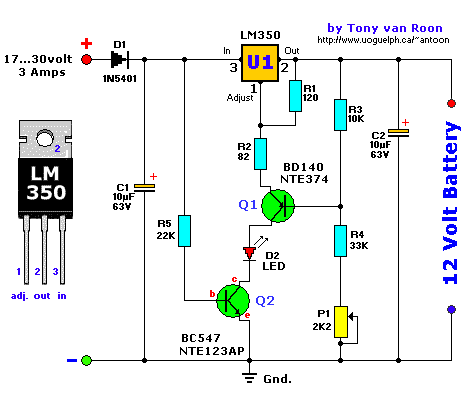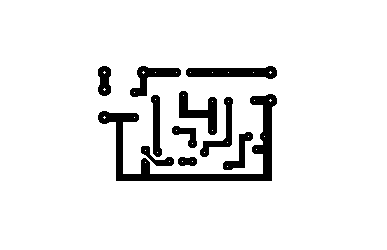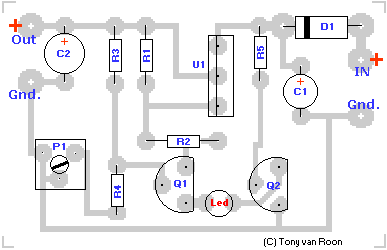Lead Acid Battery Charger
by Tony van Roon

Parts List:
R1 = 120 Ohm C1 = 100uF/63V Q1 = NTE374/BD140
R2 = 82 Ohm C2 = 10uF/63V Q2 = NTE123AP/BC547
R3 = 10K D1 = 1N5401/NTE5801 U1 = LM350 (On large coolrib!)
R4 = 33K D2 = LED (Red, 5mm)
R5 = 22K
P1 = 2K2


How it works:
Except for use as a normal Batter Charger, this circuit is perfect to 'constant-charge' a 12-Volt Lead-Acid Battery,
like the one in your flight box, and keep it in optimum charged condition. This circuit
is not recommended for GEL-TYPE batteries since it draws to much current.
The above circuit is a precision voltage source, and contains a temperature sensor with a negative temperature
coëficient. Meaning, whenever the surrounding or battery temperature increases the voltage will automatically
decrease. Temperature coëficient for this circuit is -8mV per °Celcius. A normal transistor (Q1) is used as
a temperature sensor.
This Battery Charger is centered around the LM350 integrated,
3-amp, adjustable stabilizer IC. Output voltage can be adjusted with P1 between 13.5 and 14.5 volt. T2 was added to
prevent battery discharge via R1 if no power present. P1 can adjust the output voltage between 13.5 and 14.5 volts.
R4's value can be adjusted to accommodate a bit larger or smaller window. D1 is a large power-diode, 100V PRV @ 3 amp.
Bigger is best but I don't recommend going smaller.
The LM350's 'adjust' pin will try to keep the voltage drop between its pin and the output pin at a constant value of
1.25V. So there is a constant current flow through R1. Q1 act here as a temperature sensor with the help of
components P1/R3/R4 who more or less control the base of Q1. Since the emitter/base connection of Q1, just like any
other semiconductor, contains a temperature coëficient of -2mV/°C, the output voltage will also show a
negative temperature coëficient. That one is only a factor of 4 larger, because of the variation of the
emitter/basis of Q1 multiplied by the division factor of P1/R3/R4. Which results in approximately -8mV/°C.
To prevent that sensor Q1 is warmed up by its own current draw, I recommend adding a cooling rib of sorts.
(If you wish to compensate for the battery-temperature itself, then Q1 should be mounted as close on the battery
as possible)
The red led (D2) indicates the presence of input power.
Depending on what type of transistor you use for Q1, the pads on the circuit board may not fit exactly (in case of
the BD140).
Caution: Adjust the voltage of capacitor C1 according to the input voltage. Example, if your input voltage will
be 24 volt, your C1 should be able to carry at least 50V.
Back to Gadgets Menu page
Copyright © Tony van Roon



